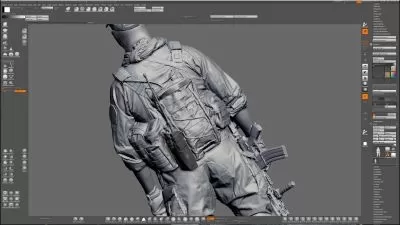CFD analysis of ONERA M6 wing - Part 2 Hexa Meshing
Sijal Ahmed
3:01:07
Description
High quality hexa meshing of ONERA M6 for most accurate and authentic results for CFD validation
What You'll Learn?
- Importing files into ICEMCFD
- Thinking about the grid toplogy
- creating hexa mesh
- creating three meshes
Who is this for?
More details
DescriptionIn this course you will learn about hexa meshing of ONERAÂ M6 wing. In first part we have made geometry of ONERAÂ M6 wing in Solidworks and now same geometry will used for making the grid.
ONERA M6 is a classical test case for CFD validation. Although geometry is simple, but the flow field involves complex flow features such as transonic flow (Mach No. 0.7 - 0.92) with shocks, boundary layer separation etc. The ONERA M6 wing was designed in 1972 by the ONERA Aerodynamics Department as an experimental geometry for studying three-dimensional, high Reynolds number flows. ONERA is a swept back wing, with half span. It is external third of M5 Wing without twist.
In this three part course series, you will learn about the conducting CFD analysis of ONERA M6 wing as per data given by AGARD AR 138 1979 by Schmitt, V. and F. Charpin.
Learning outcomes of this course:
1. At the end of this three part course/tutorial, student will be able to perform CFDÂ simulation of exteneral, viscous, compressible flow around 3D geometry at transonic conditions using various turbulence models and appropriate Y+ values.
2. Student will be able to understand/learn all processes involved in high fidelity CFD analysis such as geometry creation, meshing, CFD setup, solution and post processing.
3. Student will be able to validate CFD results against experimental data from AGARD report.
4. Following things will be covered:
Geometry generation in Solidworks
Hemisphere domain in Spaceclaim
Hexa meshing in ICEMCFD
Mesh import, boundary conditions specification, material properties, solver settings, report definitions, hybrid initialization etc.
Steady state, 3D Reynolds-Averaged Navier-Stokes
Spalart-Allmaras, K-Epislon, Shear Stress Transport SST and transition turbulence models
2nd order upwind flow scheme
Compressible, implicit solver
No slips wall, Symmetry and pressure Far-Field boundary conditions
Convergence acceleration using latest options in Fluent 2022 R1
Parallel solver
Post processing of results
Validations of results against experimental data.
solution convergence assessment based on lift and drag coefficients.
Resources:
You will get following resources in this courseÂ
1. All power point slides
2. AGARD Report
3. All files including geometry, domain, hexa mesh, solved case and data files, excel file for data, aerofoil coordinates and also geometry from NASA.
Problem Setup
This problem will solve the flow past the wing with these conditions:
Freestream Temperature = 288.15 K
Freestream Mach number = 0.8395
Angle of attack (AOA) = 3.06 deg
Reynolds number = 11.72E6
Mean aerodynamics chord = 0.64607 m
Who this course is for:
- Interested in learning CFD analysis of wings
In this course you will learn about hexa meshing of ONERAÂ M6 wing. In first part we have made geometry of ONERAÂ M6 wing in Solidworks and now same geometry will used for making the grid.
ONERA M6 is a classical test case for CFD validation. Although geometry is simple, but the flow field involves complex flow features such as transonic flow (Mach No. 0.7 - 0.92) with shocks, boundary layer separation etc. The ONERA M6 wing was designed in 1972 by the ONERA Aerodynamics Department as an experimental geometry for studying three-dimensional, high Reynolds number flows. ONERA is a swept back wing, with half span. It is external third of M5 Wing without twist.
In this three part course series, you will learn about the conducting CFD analysis of ONERA M6 wing as per data given by AGARD AR 138 1979 by Schmitt, V. and F. Charpin.
Learning outcomes of this course:
1. At the end of this three part course/tutorial, student will be able to perform CFDÂ simulation of exteneral, viscous, compressible flow around 3D geometry at transonic conditions using various turbulence models and appropriate Y+ values.
2. Student will be able to understand/learn all processes involved in high fidelity CFD analysis such as geometry creation, meshing, CFD setup, solution and post processing.
3. Student will be able to validate CFD results against experimental data from AGARD report.
4. Following things will be covered:
Geometry generation in Solidworks
Hemisphere domain in Spaceclaim
Hexa meshing in ICEMCFD
Mesh import, boundary conditions specification, material properties, solver settings, report definitions, hybrid initialization etc.
Steady state, 3D Reynolds-Averaged Navier-Stokes
Spalart-Allmaras, K-Epislon, Shear Stress Transport SST and transition turbulence models
2nd order upwind flow scheme
Compressible, implicit solver
No slips wall, Symmetry and pressure Far-Field boundary conditions
Convergence acceleration using latest options in Fluent 2022 R1
Parallel solver
Post processing of results
Validations of results against experimental data.
solution convergence assessment based on lift and drag coefficients.
Resources:
You will get following resources in this courseÂ
1. All power point slides
2. AGARD Report
3. All files including geometry, domain, hexa mesh, solved case and data files, excel file for data, aerofoil coordinates and also geometry from NASA.
Problem Setup
This problem will solve the flow past the wing with these conditions:
Freestream Temperature = 288.15 K
Freestream Mach number = 0.8395
Angle of attack (AOA) = 3.06 deg
Reynolds number = 11.72E6
Mean aerodynamics chord = 0.64607 m
Who this course is for:
- Interested in learning CFD analysis of wings
User Reviews
Rating
Sijal Ahmed
Instructor's Courses
Udemy
View courses Udemy- language english
- Training sessions 13
- duration 3:01:07
- Release Date 2022/12/06










